CBSE Previous Year Question Papers Class 12 Geography 2014 Delhi
Time allowed : 3 hours
Maximum marks: 70
True
- There are 22 questions in all.
- All questions are compulsory.
- Question number 1 to 7 are very short-answer questions carrying 1 mark each. Answer to each of these questions should not exceed 40
- Question numbers 8 to 13 are short-answer questions carrying 3 marks each. Answer to each of these questions should not exceed 80-100 words.
- Question numbers 14 to 20 are long-answer questions carrying 5 marks each. Answer to each of these questions should not exceed 150
- Question numbers 21 to 22 are related to identification or locating and labelling of geographical features on maps, carrying 5 marks each.
- Outline maps of the World and India provided to you must be attached within your answer-book.
- Use of templates or stencils for drawing outline maps is allowed.
False
True
Question 1.
Define the term ‘quaternary activities’. [1]
Answer:
The term ‘quaternary activities’ is a way to describe the knowledge-based part of the economy which typically includes services such as information generation, collection, production and dissemination of information and sharing information technology, consultation, education, research and development, financial planning, and other knowledge-based services. Government and Media are examples of it.
Question 2.
Give the meaning of ‘digital divide’. [1]
Answer:
A digital divide is an economic and social inequality according to categories of persons in a given population for their access to, use of, or knowledge of information and communication technologies (ICT ). The divide within countries, may refer to inequalities between individuals, households, businesses or geographic areas, usually at different socio-econommic levels or other demographic categories.
Question 3.
Name the sea-ports on each end of Suez Canal. [1/2 + 1/2 = 1]
Answer:
- Port Said on its north,
- Port Suez on its south.
Question 4.
Define the term ‘road density’. [1]
Answer:
Road density is the ratio of the length of the country’s total road network to the country’s land area. The road network includes all roads in the country; motorways, highways, main or national roads, secondary or regional roads, and other urban and rural roads.
Question 5.
Give any two examples of ancient towns of India. [1/2 + 1/2 = 1]
Answer:
- Varanasi (Benaras),
- Patliputra (Patna)
Question 6.
Name the country which is the largest trading partner of India. [1]
Answer:
USA.
Question 7.
Name the sea-port which was constructed to reduce the congestion at Kolkata port. [1]
Answer:
Haldia Port.
Question 8.
Name the major sea-port which was developed just after independence on the Western coast of India. [1]
Answer:
Kandla Port.
Question 9.
What is truck farming ? [1]
Answer:
Truck farming refers to growing one or more vegetable crops on a large scale for shipment to distant markets. It is usually less intensive fields are small in size and diversified than market gardening. The major truck-farming areas are in California, Texas, Florida, along the Atlantic Coastal Plain and in the Great Lakes area.
Question 10.
Mention the root cause of ‘acid rains’. [1]
Answer:
Causes of acid rain are :
- Air pollution
- Urban smog due to automobiles.
Question 11.
“There is mutual interaction between the elements of Physical Geography and Human Geography”. Support the statement with suitable examples. [3 × 1 = 3]
Answer:
Human and physical geography is the study of the environment, people, and the resources they use. Geography determines the way in which humans live, the adaptations they have developed to survive, and the alterations to the environment they have made to better their existence. The impact of human interaction with the environment has mixed results. While human life has been improved and made more comfortable, the environment has been damaged in a variety of ways.
True
Question 12.
Describe any three characteristics of ‘Household Industries’. [3 × 1 = 3]
Answer:
Characteristics of household industries are:
- It is the smallest manufacturing unit.
- They use simple hand tools to produce goods.
- Final products are locally marketed.
Question 13.
Study the map given below and answer the questions that follow: [1/2 + 1/2 + 2 = 3]
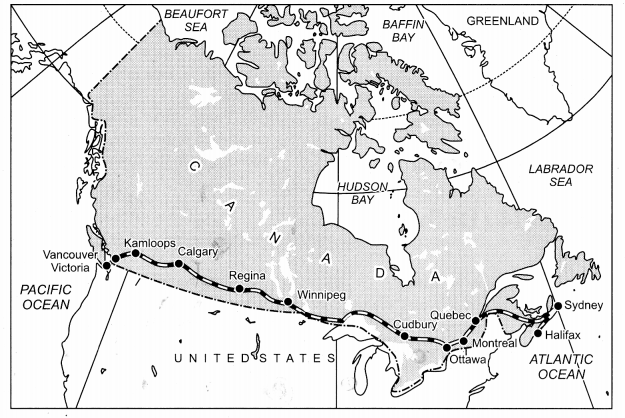
13.1. Name the railway line shown on this map.
13.2. Name the terminal station of this railway along the Atlantic coast.
13.3. Why is this railway line known as ‘economic artery’ of the country through which it passes ?
Answer:
13.1. Trans-Canadian Railway
13.2. Halifax
13.3. Because it connects the agricultural region with the industrial region.
Question 14.
Differentiate between rural and urban settlements of India in three points. [3 × 1 = 3]
Answer:
- Rural settlements depend upon primary economic activities whereas urban settlement depends upon secondary and tertiary sectors of economy.
- Rural settlement produces food grains and raw materials. Urban settlement gives goods or service to others.
- Rural settlements are small in size and sparsely located. Urban settlements are fewer but of large size.
Question 15.
State any two characteristics each of the three distinct ‘cropping seasons’ of India. [3 × 1 = 3]
Answer:
The three distinct cropping seasons are :
Kharif season :
- This season depends upon south west monsoon.
- This season falls between June to September.
-
Major crops :
Rice, jowar, maize, bajra, etc.
False
- This season begins with onset of winter.
- The period of this season is from October to March.
- Major crops – Wheat, gram, mustard, barley, etc.
False
- It is a short duration between Rabi and Kharif.
- Major crops of the season are — Watermelon, fruits, vegetables, fodder crops.
Question 16.
Explain any three main characteristics of mineral resources of India. [3 × 1 = 3]
Answer:
- India has a large number of economically useful minerals but unevenly distributed over space and they constitute one-quarter of the world’s known mineral resources.
- About two-third of its iron deposits lies in the belt along Odisha and Bihar border.
- India has the world’s largest deposits of coal. Bituminous coal is found in Jharia and Bokaro in Bihar and Raniganj in West Bengal. Lignite coal is found in Neyveli in Tamil Nadu.
Question 17.
Describe any three advantages of satellite communication in India. [3 × 1 = 3]
Answer:
- It is used for weather forecast and monitoring natural calamities.
- It is used for border surveillance.
- It makes communication faster.
Question 18.
Why is the ‘Urban Waste Disposal’ a serious problem in India ? Explain any three reasons. [3 × 1 = 3]
Answer:
- Localized environmental health problems such inadequate household water and sanitation and indoor air pollution.
- City-regional environmental problems such as ambient air pollution, inadequate waste management and pollution of rivers, lakes and coastal areas.
- Impact of urban activities such as ecological disruption and resource depletion in a city’s hinterland, and emissions of acid precursors and I greenhouse gases.
- Regional or global environmental burdens that arise from activities outside a city’s boundaries, but I which will affect people living in the city.
Question 19.
Study the diagram given below, showing the I location of an important steel plant in India, and answer the questions that follow :[1 + 1 + 1 = 3]
(i) Identify the steel plant and name it.
(ii) Mention the thermal power plant which supplies power to it.
(iii) Mention the source of water for this plant.
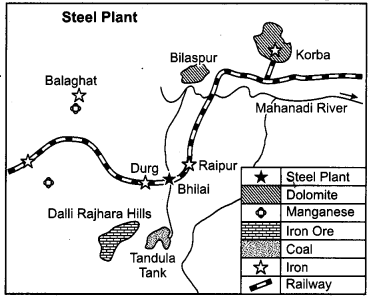
Answer:
(i) Bhilai Steel Plant
(ii) Korba Thermal Plant supplies power to it.
(iii) Tandula Tank is the main water source.
Question 20.
Analyse the economic and social values of rainwater harvesting. **[3]
Question 21.
Explain the three components of population change in the world. Analyse the impacts of population change. [3 + 2 = 5]
Answer:
Components of population change in the world are :
(i) Higher birth rate
(ii) Lower death rate
(iii) Migration.
False
- In developing countries like India the levels of maternal and infant mortality are very high. Repeated childbirths are seen as an insurance against multiple infant and child deaths. Vast numbers of people cannot avail of the services provided by government sponsored family planning programmes even when they are available, due to problems of knowledge and its access.
- As the population grows, the pressure on natural resources will increase.
- Population pressure will reduce the per capita availability of land for farming, which will affect availability of food grain, drinking water etc.
- Pressure on basic amenities also increases due to change in population.
Question 22.
Describe any five characteristics of ‘Commercial Livestock Rearing’ practised in the world.
[5 × 1 = 5]
Answer:
Characteristics of Commercial Livestock Rearing practice are :
- It is more organized and capital-intensive activity.
- It is practiced on permanent ranches.
- Parcels are fenced to regulate the grazing.
- The number of animals in a pasture is kept according to the carrying capacity of the pasture.
- The basic emphasis is on breeding, genetic improvement, disease control and healthcare of the animals.
Question 23.
Differentiate between Bilateral trade and Multilateral trade. Explain how ports are helpful in trade. [2 + 3 = 5]
Answer:
(i) Bilateral Trade : It is the exchange of goods between two countries. Bilateral trade agreements give preference to certain countries in commercial relationships, facilitating trade and investment between the home country and the foreign country by reducing or eliminating tariffs, import quotas, export restraints and other trade barriers. Bilateral trade agreements can also help minimize trade deficits.
True
True
Question 24.
Describe any five patterns of rural settlements in the world on the basis of forms of shapes. [5 × 1 = 5]
Answer:
On the basis of forms of shapes, the five patterns of rural settlements in the world are :
- Linear Pattern – In such settlements, houses are located along a road, railway fine, river or a canal edge.
- Rectangular Pattern — In such pattern, roads cut each other at right angle. These patterns can be seen in plain areas.
- Circular Pattern – Such patterns develop around lakes, tanks or likewise places.
- Star like Pattern — In the pattern, several roads converge star shaped settlements developed by houses built along the roads.
- T-shaped Pattern – Such pattern develops at tri-junction of roads.
Question 25.
“The decades 1921-51 are referred to as the period of steady growth of population whereas the decades 1951-1981 are referred to as the period of population explosion in India.” Explain giving reasons. [21/2 + 21/2 = 5]
Answer:
1921-51 are considered to be period of steady growth because :
- During this period the population increased from 251 million to 361 million.
- The mortality rate started to decline due to improvement in general health and sanitation conditions.
- The crude birth rate remained high the combined effect of these factors was that the population started increasing steadily.
Period of Population Explosion : 1951-81 Period of Population Explosion : 1951-81 Period of Population Explosion : 1951-81 Period of Population Explosion : 1951-81 Period of Population Explosion : 1951-81 Period of Population Explosion : 1951-81 Period of Population Explosion : 1951-81 Period of Population Explosion : 1951-81 Period of Population Explosion : 1951-81 Period of Population Explosion : 1951-81 Period of Population Explosion : 1951-81 Period of Population
- After 1951, there was a steady pace in the mortality rate.
- The fertility rate remained high.
- This unprecedented growth rate was due to the improvement in wealth facilities, living condition. Death rate declined much faster than the birth rates. This resulted in high natural increase. Thus their period is called the period of population explosion.
Question 26.
(i) In the given political outline Map of the world four features A, B, C and D have been shown. Identify these features with the help of information given below and write their correct names on the lines drawn near them. [4 × 1/2 = 2]
(A) An important sea port
(B) A terminal station of Australian Trans-continental Railway
(C) An Area of subsistence gathering
(D) The country with lowest growth rate of population (1995-2000) in Asia.
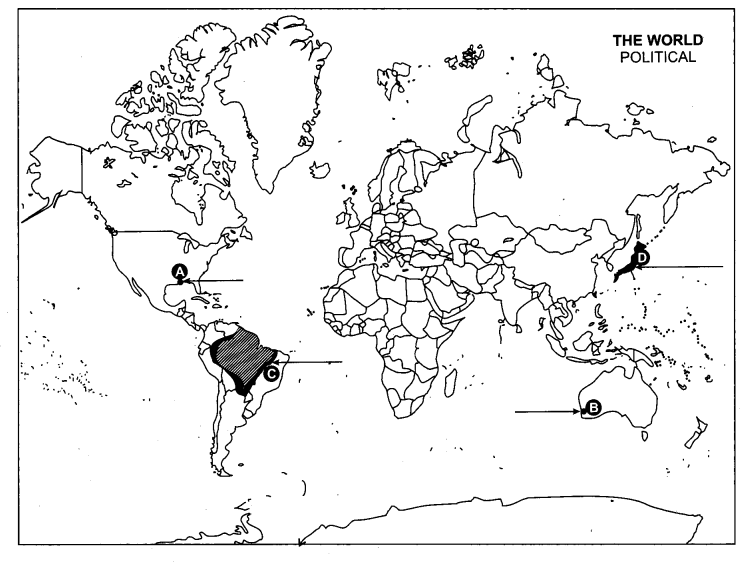
Answer:
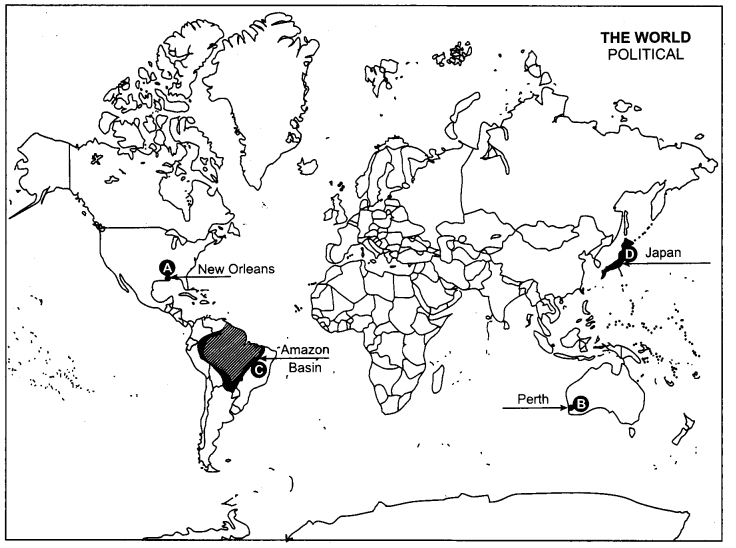
(ii) On the given political outline map of India, locate and label the following with appropriate symbols :
(A) The state having highest literacy rate.
(B) The leading state in the production of Jute.
(C) The northern most international airport.
Answer:
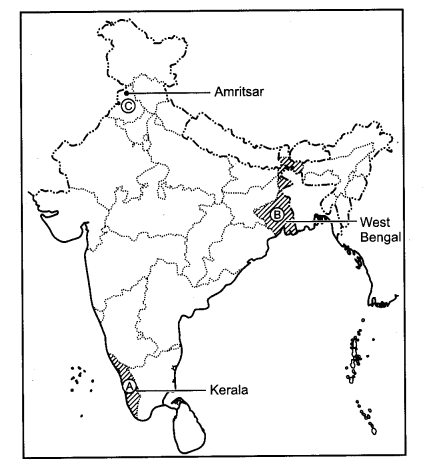
True
False
Question 4.
Mention the busiest ocean route of the world. [1]
Answer:
North-Atlantic sea route or big trunk route.
Question 7.
Name the port developed as a satellite port to relieve the pressure at Mumbai port. [1]
Answer:
Jawahar Lai Nehru port.
Question 12.
What are the traditional large scale industrial regions ? Give any two characteristics of them. [1 + 2 = 3]
Answer:
Traditional large scale industries are based on heavy industries. These are often located near coal fields and engaged in metal smelting, heavy engineering, chemical manufacturing and textile production. Some characteristics of this are :
- High proportion of employment.
- Unattractive environment.
Question 15.
Explain the main aims of ‘Bharmaur Tribal Area Development Plan’ ? [3 × 1 = 3]
Answer:
The main aims of Bharmaur Tribal Area Development Plan are :
- This plan aims at improving the quality of life of Gaddis.
- It also seeks at the development of transport, communication, agriculture and allied activities.
- It also aims at the development of infrastructure like—Schools, Hospitals and Primary Check-up centres and ensures proper water and electricity supply.
Question 23.
What is the role of ‘World Trade Organization’ as an International Organization ? Why has the World Trade Organization been criticized by some countries ? Explain. [2 + 3 = 5]
Answer:
The World Trade Organization (WTO) is the only global international organization dealing with the rules of trade between nations. At its heart are the WTO agreements, negotiated and signed by the bulk of the world’s trading nations and ratified in their parliaments. The goal is to help producers of goods and services, exporters, and importers to conduct their business. Role of WTO are :
(i) Trade Negotiation : The WTO regulates agreements over goods, services and intellectual property. They spell out the principles of liberalization, and the permitted exceptions. They include individual countries’ commitments to lower customs tariff and other trade barriers, and to keep open services markets.
(i) Implementation and Monitoring : All WTO members must undergo periodic scrutiny of their trade policies and practices, each review containing reports by the country concerned and the WTO Secretariat.
iii) Dispute Settlement : The WTO’s procedure for resolving trade quarrels under the Dispute Settlement understanding is vital for enforcing the rules and therefore for ensuring that trade flows smoothly.
False
Question 25.
Define the term ‘migration’. Explain the social and environmental consequences of migration in India. [1 + 2 + 2 = 5]
Answer:
Migration is the movement by people from one place to another with the intention of settling in the new location. The movement is typically over long distances and from one country to another, but internal migration is also possible. Migration may be by individuals, family units or large groups.
False
both phenomena are in reversible, proportional correlation and figure more apparently just before during the shortly after upon the undesirable environmental changes . both phenomena are in reversible, proportional correlation and figure more apparently just before during the shortly after upon the undesirable environmental changes .
True
False
Question 1.
Give the meaning of ‘retail trading’ services. [1]
Answer:
Retail trading services are component of domestic trade and the concluding phase of the circulation of personal consumption, in which goods and services are sold in exchange for the monetary income of the population. Retailers are business firms engaged in offering goods and services directly to consumers.
Question 8.
Define the term ‘Hinter Land’ of the port. [1]
Answer:
Hinter Land of the port is an area from which products are delivered to a port for shipping. It is the area in land from the port to which imports are distributed and from which exports are collected.
Question 12.
Explain the meaning of ‘technopolies’. Give two examples of technopolies. [2 + 1 = 3]
Answer:
High-tech industries which are regionally concentrated, self-sustained and highly specialized are called technopolies. Technopolies are neatly spaced, low, modern, dispersed, office-plant-lab buildings rather than massive assembly structures, factories and storage areas mark the high-tech industrial landscape. Planned business parks for high- tech start-ups are also a part of technopolies. The Silicon valley near San Francisco and Silicon forest near Seattle are examples of technopolies.
Question 17.
Explain the significance of internet services in the field of personal communication system in India. [3]
Answer:
In India, among all personal communications, Internet services play a significant role. They enable the user to establish the direct contact through e-mail to get access to the world of knowledge and information. Its demand is increasing day-by-day for e-commerce and carrying out money transaction. The internet is a huge central warehouse of data, with detailed information on various items, which enables the basic facilities of direct communication at very low cost.
Question 18.
Explain with examples, how the industries are responsible for polluting water resources in India. [3 × 1 = 3]
Answer:
The dumping of industrial waste into rivers leads to water pollution. Industries generate ordinary domestic sewage that can be treated by municipal facilities but those industries that generate waste water with high concentrations of conventional pollutants (eg., oil and grease), toxic pollutants (eg., heavy metals, volatile organic compounds) or other non-conventional pollutants such as ammonia are highly responsible for polluting the water resources. When these enter the water resources from industries deteriorate the quality of water and render it unfit for human use. This in turn, limits the availability of usable water resources. Most industries in India do not follow the norms and let the waste water go into the rivers without the process of detoxification. For example—The Yamuna River is the most polluted river in the country between Delhi and Etawah. This is just because industries between these two cities do not detoxify their waste water. Other severely polluted river is the Sabarmati river at Ahmedabad.
Question 21.
Give the meaning of ‘human development’. Explain the four pillars of human development. [1 + 4 = 5]
Answer:
Human development is defined as the process of enlarging people’s freedoms and opportunities and improving their well-being. Human development is about the real freedom ordinary people have to decide who to be, what to do, and how to live.
True
- Equity: Equity is the idea of fairness for every person, between men and women; we each have the right to an education and health care.
- Sustainability : Sustainability is the view that we all have the right to earn a living that can sustain our lives and have access to a more even distribution of goods.
- Productivity : Productivity states the full participation of people in the process of income generation.
- Empowerment: Empowerment is the freedom of the people to influence development and decision that affect their lives.
Question 25.
Explain why Kerala has a higher level of human development than other States of India. [5]
Answer:
Freedom from hunger, poverty, servitude, bondage, ignorance, illiteracy and any other form of domination is the key to human development.
False
True
Kerala has made significant achievements in most of the fields of Human Development like free from illness and ailment and living a reasonably long life span and indicative of a healthy life . Availability of pre and post natal health care facilities in order to reduce infant mortality and post-delivery deaths among mothers, old age healthcare, adequate nutrition and safety of individual are some important measures of a healthy and reasonably long life span. Kerala has made significant achievements in most of the fields of Human Development like free from illness and ailment and